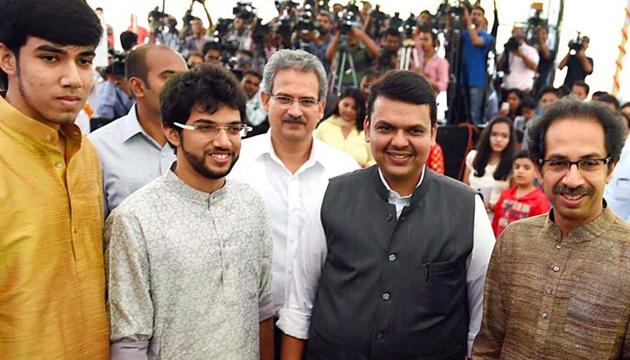What other NDA allies can learn from BJP-Sena tussle, writes Rajdeep Sardesai
The BJP must now assess how far it can push on the basis of its hitherto unchallenged political supremacy
Bharatiya Janata Party (BJP) leader, the late Pramod Mahajan, would happily relate a story of how in 1990, when he cemented an alliance with the Shiv Sena in the Maharashtra Vidhan Sabha for the first time, Sena chieftain Bal Thackeray just scribbled a number on a piece of paper. “We fight 200 seats, you fight the rest,” Thackeray bluntly told the BJP leader. The deal was done in less than half an hour. The Sena would eventually fight 183 seats and the BJP 105 in the 288 member assembly.

Fast forward now to 2019 with the BJP offering a virtual fait accompli to the Sena, giving it little option but to accept a role as a junior partner in the saffron alliance. This dramatic shift reflects how the BJP under the leadership of Narendra Modi and Amit Shah at the Centre and Devendra Fadnavis at the state, has completely reworked the power axis in the state.
For the Sena, this transfer of power is particularly problematic: Being held hostage to the national dominance of two Gujaratis is a bitter pill to swallow for a party that emerged from the womb of Maharashtrian nativism, especially given past antagonisms during the Samyukta Maharashtra statehood movement. In effect, the Marathi manoos is being shown a subordinate place on his home turf.
Also Watch l Maharashtra Chief Minister will be from Shiv Sena only: Sanjay Raut
Which might partly explain the Shiv Sena’s determination to push the BJP to the brink in government formation by insisting on rotational chief ministership. In 2014, when the two sides fought separately, the Sena had little choice but to accept whatever terms and conditions the BJP imposed in a post-poll deal.
The party did not get a single major portfolio in Maharashtra, was given just one relatively inconsequential Cabinet berth in Delhi, an ailing Uddhav Thackeray was marginalised as a soft leader and Fadnavis was pitched as Maharashtra’s neta number one. The turning point was the 2017 Mumbai municipal elections when the BJP breached the Sena’s original fortress successfully: While the Sena won 84 seats, the BJP tally jumped sharply from 31 to 82 seats.
While the Sena’s image as a regional party was a constraint in attracting Mumbai’s large north Indian migrant population, the BJP was able to assert itself as a mascot of Hindu nationalism. Consequently, the party which, took pride in the Bal Thackeray era that one roar from its supremo was enough to bring Mumbai to a halt has been confronted with the prospect of being reduced to a paper tiger. Hence its increasingly aggressive posturing and targeting of the BJP.
Which is also why this 2019 election was a make or break one for the Sena. Which is why Aaditya Thackeray at the age of 29 was pushed into the election arena signaling an end to the remote control politics of the Thackeray family who have consistently opted out of contesting elections themselves. The final results have only confirmed the widening gap between the BJP and the Sena: the BJP won 105 of the 164 seats contested on its symbol, a strike rate of over 70%, while the Sena won 56 of the 124 seats it contested, a strike rate well below 50%. But unlike in T-20 cricket, strike rates don’t matter in electoral politics; the fact is, the BJP is 39 seats short of the majority number in Maharashtra, giving the Sena enough leeway to play a decisive role in government formation. In 2014, the fear of being isolated forced the Sena to accept the BJP’s diktat; in 2019, the BJP’s dependence on Sena support is enough for it to drive a hard bargain.
That’s not the only twist in the tale. In 2014, the Sharad Pawar-led NCP was willing to explore options of co-habiting with the BJP; in 2019, after being served an Enforcement Directorate notice, and finding his party being poached upon and divided, Pawar seems determined to give the BJP sleepless nights by fishing in troubled waters. As for the Congress, it seems to be in a bit of a bind: keen to prevent another BJP-led government in a resource-rich state but unwilling to openly align with the communal Sena (interestingly, Bal Thackeray supported the Emergency in 1975 and didn’t put up candidates against the Indira-led Congress in the 1977 and 1980 elections).
In this game of political brinkmanship, there is a larger question which will confront the Modi-Shah-led BJP sooner or later: just how far can it push restive allies in the belief that its supremacy is unchallenged? The Sena may eventually fall in line after getting a few key ministries but does the Maharashtra Mahabharat mark the beginning of the end of the NDA experiment of coalition building? It is the Sena today, will it be Nitish Kumar and the Janata Dal United in Bihar tomorrow?
Post-script: Every election throws up kings and king-makers. Maharashtra 2019 has been peculiar in that the star of the show at the moment is not any of the obvious names. If you need any proof that journalists can at times make successful politicians, look no further than the Sena MP and Saamna editor Sanjay Raut. The man who entered politics after doing a lengthy interview with Bal Thackeray is now the loudest voice of the Sena in Maharashtra!






